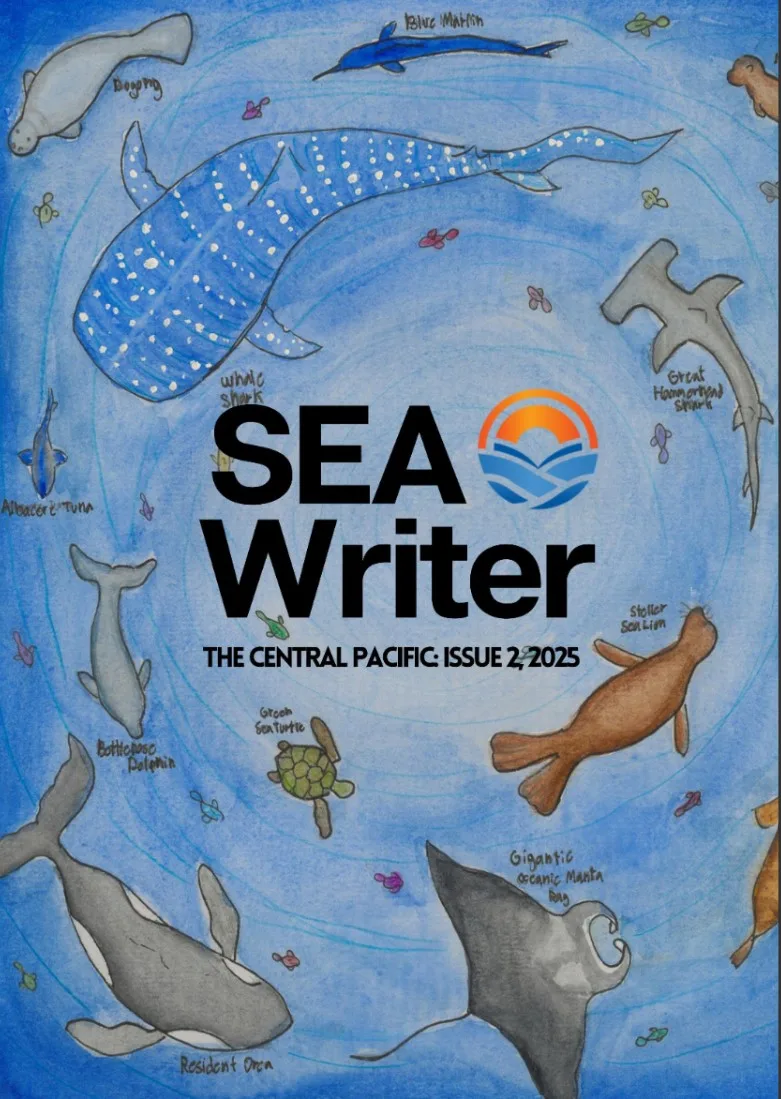News
SEAWriter: SeaQuest (Issue 2, 2025)

Introduction by Caitlyn Sullivan
This past summer, a group of students immersed themselves in one of the ocean’s most dynamic and threatened regions, the central Pacific, as part of a three-week seminar. Framed around the challenges facing Pacific Island nations, the seminar centered on the intersection of marine conservation, climate change, and science communication, offering students a unique opportunity to explore both the scientific and cultural dimensions of ocean health.
Throughout the course, students gained a multi-layered understanding of marine ecosystems and how they are being altered by human activity. They studied the latest scientific research on coral reef decline, learning how rising sea temperatures and ocean acidification are causing widespread bleaching and reshaping reef biodiversity. In tandem, they explored the science behind plastic pollution, both its sources and its long-term ecological consequences, as well as the complexities of proposed solutions like bans, recycling reforms, and emerging cleanup technologies.
Guest lectures added additional layers of expertise and perspective. Plastics researcher Dr. Kara Lavender Law introduced students to microplastic distribution studies and the modeling tools used to trace debris across ocean currents. Dr. Heather Page, a coral reef ecologist, discussed the vulnerability of reef systems and how localized protections can buffer against global stressors. Captain Christopher Nolan, a retired U.S. Coast Guard officer with expertise in Pacific maritime enforcement, offered insights into the governance challenges of protecting vast, remote waters from illegal fishing and exploitation.
Kareati Waysang, who now works with the Ministry of Finance in Kiribati, joined the seminar to share her personal insights on life in one of the world’s most remote island nations. Drawing on her past experience as an outreach and education officer for the Phoenix Islands Protected Area (PIPA), she spoke about the deep connection between I-Kiribati people and the ocean—and the everyday challenges of living in a place threatened by sea-level rise, limited freshwater, and economic isolation. Her perspective helped students better understand the human dimensions of climate change and the resilience of Pacific Island communities.
Current undergrad students Olivia Hines and Resh Mukherjee shared their experience of their study abroad voyage with SEA from Aotearoa New Zealand to Tahiti. They guided the students through the timelines of the program, and each presented their study topic, providing deep insight into their topics while giving the students a taste of college academics. Students also engaged deeply with cultural perspectives on ocean stewardship. Writer and reef fisheries scientist Dr. Shreya Yadav, based in Hawai‘i, spoke on the traditional knowledge systems that guide sustainable marine use in Polynesian communities. Her session emphasized the importance of respecting and integrating Indigenous ecological knowledge into modern conservation policy, a recurring theme throughout the seminar. These discussions led students to reflect on the role of cultural resilience and local leadership in addressing the global climate crisis.
A particular focus of the course was on science communication. With guidance from Rich King and senior editor Rebecca Kessler at Mongabay, students analyzed how marine science is reported and how language shapes public understanding of environmental issues. We examined examples of storytelling, from personal narratives to data-driven investigative pieces, and practiced translating technical content for a general audience. This skill-building exercise underscored that conservation isn’t just about data, but about conveying urgency and possibility in ways that resonate.
As part of the seminar, each student selected a recent peer-reviewed scientific study related to the Pacific Ocean and transformed it into a piece of science journalism. This assignment challenged students to translate complex research into clear, engaging narratives for a general audience— applying the communication strategies they had studied throughout the course. Topics ranged from sperm whale vocal clans to threats for sea turtles, the effect of fisheries, and ocean microplastics, reflecting the diverse interests and growing expertise of the group.
This issue of SEA Writer aims to inspire curiosity and deepen understanding of the Pacific Ocean by sharing stories that blend science, culture, and conservation. Through student voices and expert insights, it highlights the region’s ecological richness and the urgent challenges it faces, encouraging readers to see the ocean not just as a vast expanse, but as a living, interconnected world worth protecting.
About SEAWriter
SEAWriter is a student-published magazine, usually created as part of SEA’s Environmental Communications course. Each edition features articles, creative writing, and artwork contributed by program students and faculty. Environmental communication is essential in raising awareness, inspiring action, and bridging the gap between science and society. SEAWriter serves as a culmination of everything students have learned in all their courses and research as well as their field component. Through storytelling and visual expression, students apply their knowledge and creativity to effectively convey environmental messages to a broader audience.
To explore past issues of Sea Writer, visit our ISSUU page: https://issuu.com/sea_semester